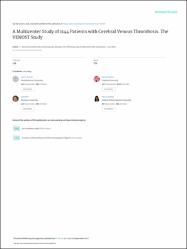| dc.contributor.author | Duman, Taşkın | |
| dc.contributor.author | Uludüz, Derya | |
| dc.contributor.author | Midi, İpek | |
| dc.contributor.author | Bektaş, Hesna | |
| dc.contributor.author | Kablan, Yüksel | |
| dc.contributor.author | Göksel, Başak K. | |
| dc.contributor.author | Milanlıoğlu, Aysel | |
| dc.contributor.author | Örken, Dilek Necioğlu | |
| dc.contributor.author | Aluçlu, Ufuk | |
| dc.contributor.author | Çolakoğlu, Sena | |
| dc.contributor.author | Tüfekçi, Ahmet | |
| dc.contributor.author | Bakar, Mustafa | |
| dc.contributor.author | Nazlıel, Bijen | |
| dc.contributor.author | Taşçılar, Nida | |
| dc.contributor.author | Göksan, Baki | |
| dc.contributor.author | Kozak, Hasan Hüseyin | |
| dc.contributor.author | Demir, Serkan | |
| dc.contributor.author | Mısırlı, Cemile Handan | |
| dc.contributor.author | Küçükoğlu, Hayriye | |
| dc.contributor.author | Çınar, Nilgün | |
| dc.contributor.author | Domaç, Füsun Mayda | |
| dc.contributor.author | Öztürk, Şerefnur | |
| dc.contributor.author | Yayla, Vildan | |
| dc.contributor.author | Karahan, Ali Yavuz | |
| dc.contributor.author | Afşar, Nazire | |
| dc.contributor.author | Göksu, Eylem Özaydın | |
| dc.contributor.author | Mengüllüoğlu, Necdet | |
| dc.contributor.author | Aytaç, Emrah | |
| dc.contributor.author | Yeşilot, Nilüfer | |
| dc.contributor.author | İnce, Birsen | |
| dc.contributor.author | Yalın, Özgür Osman | |
| dc.contributor.author | Oruç, Serdar | |
| dc.contributor.author | Demirci, Seden | |
| dc.contributor.author | Şenol, Mehmet Güney | |
| dc.contributor.author | Yılmaz, Arda | |
| dc.contributor.author | Gökçe, Mustafa | |
| dc.contributor.author | Küspeci, Zeynep Batur | |
| dc.contributor.author | Açıkgöz, Mustafa | |
| dc.contributor.author | Zeydan, Burcu | |
| dc.contributor.author | Özdağ, Murat | |
| dc.contributor.author | Yaman, Mehmet | |
| dc.contributor.author | Yürekli, Vedat Ali | |
| dc.contributor.author | Tekeli, Hakan | |
| dc.contributor.author | Genç, Hamit | |
| dc.contributor.author | Utku, Uygar | |
| dc.contributor.author | Tokuç, Firdevs Ezgi Uçan | |
| dc.contributor.author | Uzuner, Nevzat | |
| dc.date.accessioned | 2020-12-19T19:48:28Z | |
| dc.date.available | 2020-12-19T19:48:28Z | |
| dc.date.issued | 2017 | |
| dc.identifier.citation | Duman, T., Uluduz, D., Midi, I., Bektas, H., Kablan, Y., Goksel, B. K., Milanlioglu, A., Necioglu Orken, D., Aluclu, U., & VENOST Study Group (2017). A Multicenter Study of 1144 Patients with Cerebral Venous Thrombosis: The VENOST Study. Journal of stroke and cerebrovascular diseases : the official journal of National Stroke Association, 26(8), 1848–1857. https://doi.org/10.1016/j.jstrokecerebrovasdis.2017.04.020 | en_US |
| dc.identifier.issn | 1052-3057 | |
| dc.identifier.issn | 1532-8511 | |
| dc.identifier.uri | https://doi.org/10.1016/j.jstrokecerebrovasdis.2017.04.020 | |
| dc.identifier.uri | https://hdl.handle.net/11436/2087 | |
| dc.description | Senol, M. Guney/0000-0001-6397-9293; Genc, Hamit/0000-0002-6198-2883; UZUNER, NEVZAT/0000-0002-4961-4332; Yesilot, Nilufer/0000-0002-9655-9487; Kozak, Hasan Huseyin/0000-0001-6904-8545; Afsar, Nazire/0000-0001-8123-8560; Uzuner, Nevzat/0000-0002-4961-4332; karahan, ali yavuz/0000-0001-8142-913X; Kusbeci, Ozge Yilmaz/0000-0002-4048-210X; Batur Caglayan, Hale/0000-0002-3279-1842; Tascilar, Nida/0000-0003-0780-0783; Zeydan, Burcu/0000-0002-2270-9868; Nazliel, Bijen/0000-0002-6148-3814; Ekmekci, Hakan/0000-0002-5605-2980 | en_US |
| dc.description | WOS: 000407019200036 | en_US |
| dc.description | PubMed: 28583818 | en_US |
| dc.description.abstract | Background: Based on a number of small observational studies, cerebral venous sinus thrombosis has diverse clinical and imaging features, risk factors, and variable outcome. in a large, multicenter cerebral venous thrombosis (VENOST) study, we sought to more precisely characterize the clinical characteristics of Caucasian patients. Methods: All data for the VENOST study were collected between the years 2000 and 2015 from the clinical follow-up files. Clinical and radiological characteristics, risk factors, and outcomes were compared in terms of age and sex distribution. Results: Among 1144 patients 68% were women, and in older age group (>50 years) male patients were more prevalent (16.6% versus 27.8%). the most frequent symptoms were headache (89.4%) and visual field defects (28.9%) in men, and headache (86.1%) and epileptic seizures (26.8%) in women. Gynecological factors comprised the largest group in women, in particular puerperium (18.3%). Prothrombotic conditions (26.4%), mainly methylenetetrahydrofolate reductase mutation (6.3%) and Factor V Leiden mutation (5.1%), were the most common etiologies in both genders. 8.1% of patients had infection-associated and 5.2% had malignancy-related etiology that was significantly higher in men and older age group. Parenchymal involvement constitutively hemorrhagic infarcts, malignancy, and older age was associated with higher Rankin score. Epileptic seizures had no effect on prognosis. Conclusions: Clinical and radiological findings were consistent with previous larger studies but predisposing factors were different with a higher incidence of puerperium. Oral contraceptive use was not a prevalent risk factor in our cohort. Malignancy, older age, and hemorrhagic infarcts had worse outcome. (c) 2017 National Stroke Association. Published by Elsevier Inc. All rights reserved. | en_US |
| dc.language.iso | eng | en_US |
| dc.publisher | Elsevier | en_US |
| dc.rights | info:eu-repo/semantics/openAccess | en_US |
| dc.subject | Cerebrovascular disease | en_US |
| dc.subject | erebral venous sinus thrombosis | en_US |
| dc.subject | Clinic | en_US |
| dc.subject | Imaging | en_US |
| dc.title | A multicenter study of 1144 patients with cerebral venous thrombosis: the VENOST study | en_US |
| dc.type | article | en_US |
| dc.contributor.department | RTEÜ, Tıp Fakültesi, Dahili Tıp Bilimleri Bölümü | en_US |
| dc.contributor.institutionauthor | Tüfekçi, Ahmet | |
| dc.identifier.doi | 10.1016/j.jstrokecerebrovasdis.2017.04.020 | |
| dc.identifier.volume | 26 | en_US |
| dc.identifier.issue | 8 | en_US |
| dc.identifier.startpage | 1848 | en_US |
| dc.identifier.endpage | 1857 | en_US |
| dc.relation.journal | Journal of Stroke & Cerebrovascular Diseases | en_US |
| dc.relation.publicationcategory | Makale - Uluslararası Hakemli Dergi - Kurum Öğretim Elemanı | en_US |


















